The Role of Wind and Solar in the Swiss Energy Strategy 2050
VerifiedAdded on 2020/04/21
|82
|20929
|35
Report
AI Summary
This report examines the Swiss Energy Strategy 2050, focusing on the integration of wind and solar energy within Switzerland's electricity market. The paper explores the background of the study, the current state of the electricity market in Switzerland and neighboring countries, and the problem statement. The research investigates the role of wind and solar energy, electricity transmission systems, and the three pillars of the Energy Strategy 2050. The methodology includes data collection, analysis, and scenario modeling to assess electricity flow, price, demand, and supply. The analysis covers different scenarios, including base case and delay scenarios, examining the impacts of network extension delays, and the influence of the energy transition on the Swiss electricity market. The report concludes with recommendations for future research and addressing the research aims and objectives. The report also examines the legal responsibilities, liberalization, and structure of the Swiss power market, along with the financing approaches for solar and wind energy, considering both private and public sectors.
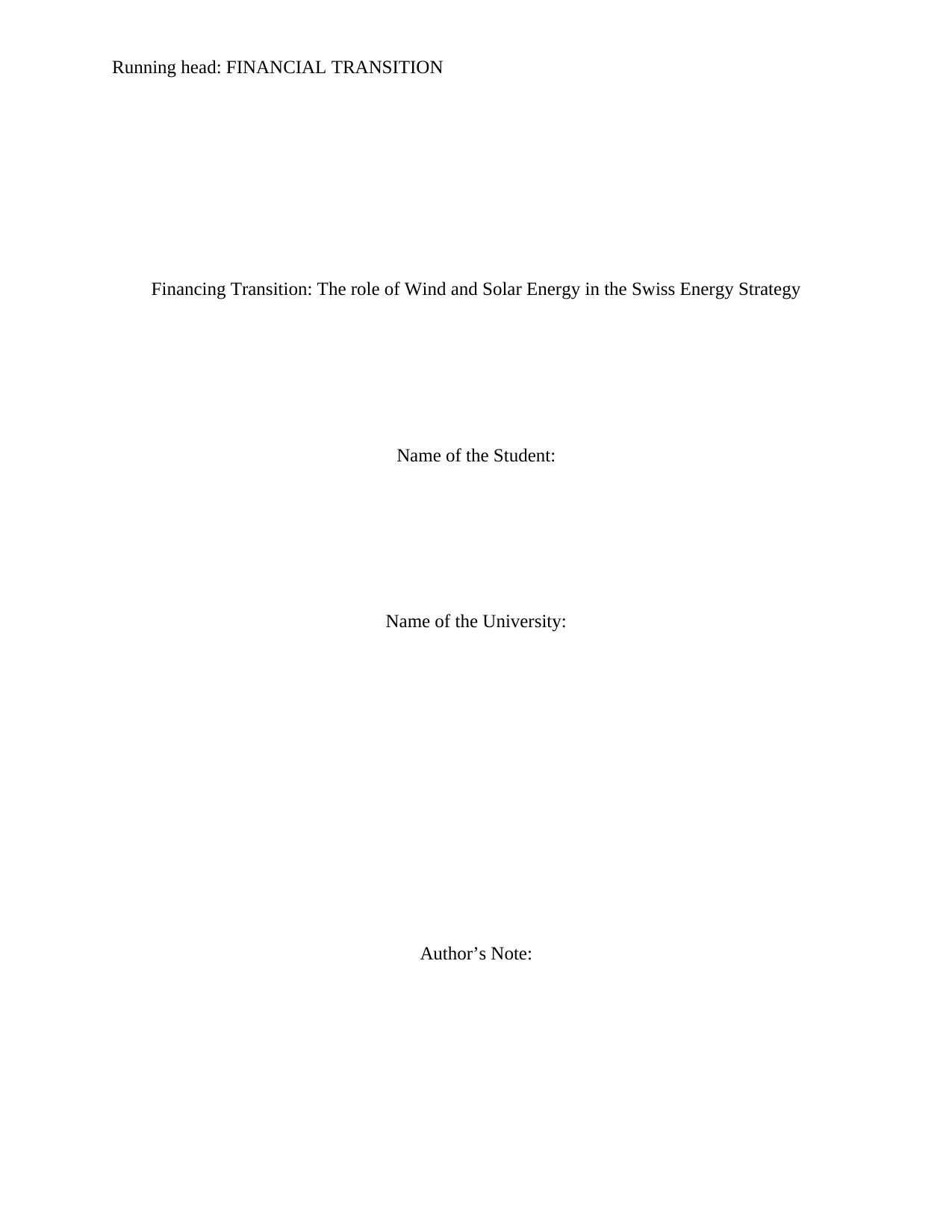
Running head: FINANCIAL TRANSITION
Financing Transition: The role of Wind and Solar Energy in the Swiss Energy Strategy
Name of the Student:
Name of the University:
Author’s Note:
Financing Transition: The role of Wind and Solar Energy in the Swiss Energy Strategy
Name of the Student:
Name of the University:
Author’s Note:
Paraphrase This Document
Need a fresh take? Get an instant paraphrase of this document with our AI Paraphraser
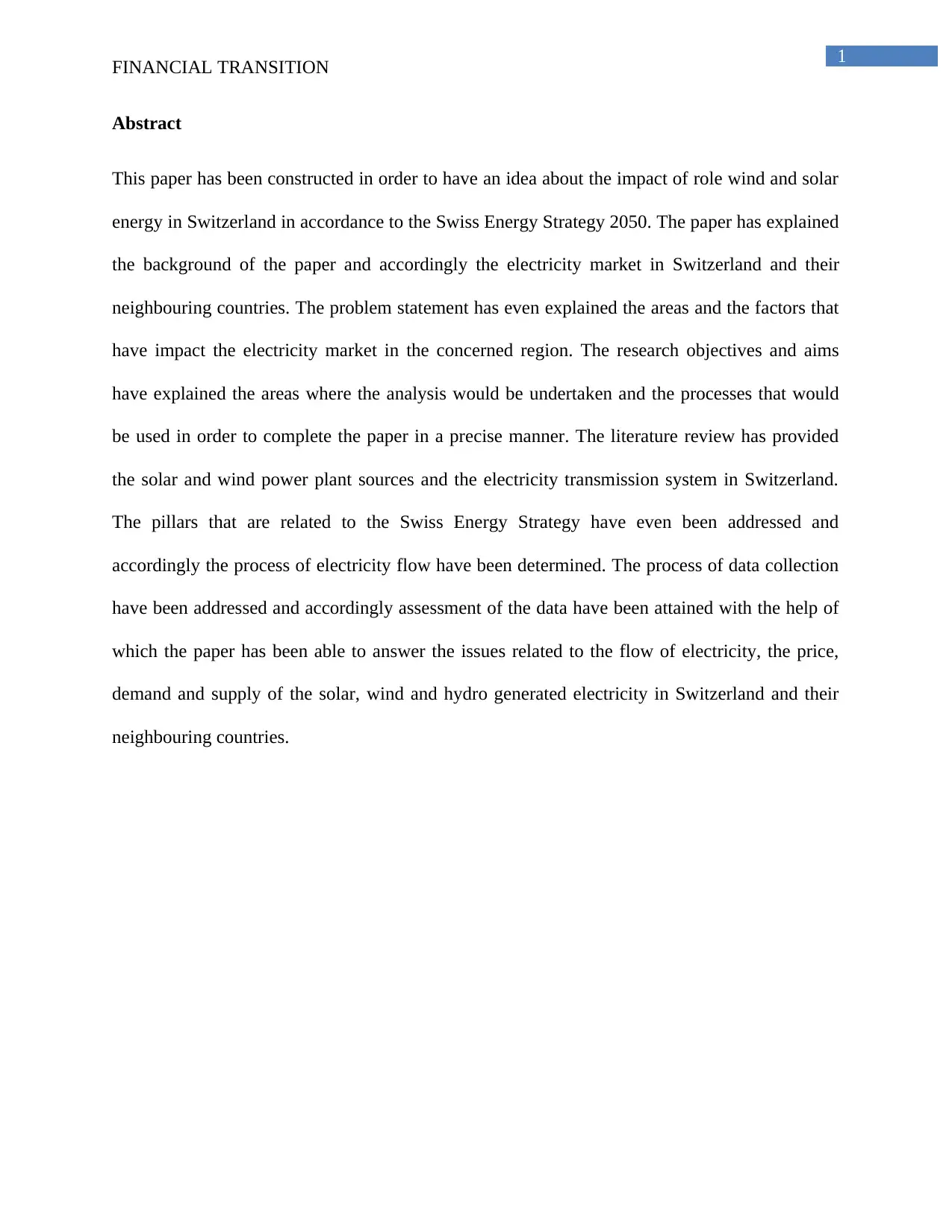
1
FINANCIAL TRANSITION
Abstract
This paper has been constructed in order to have an idea about the impact of role wind and solar
energy in Switzerland in accordance to the Swiss Energy Strategy 2050. The paper has explained
the background of the paper and accordingly the electricity market in Switzerland and their
neighbouring countries. The problem statement has even explained the areas and the factors that
have impact the electricity market in the concerned region. The research objectives and aims
have explained the areas where the analysis would be undertaken and the processes that would
be used in order to complete the paper in a precise manner. The literature review has provided
the solar and wind power plant sources and the electricity transmission system in Switzerland.
The pillars that are related to the Swiss Energy Strategy have even been addressed and
accordingly the process of electricity flow have been determined. The process of data collection
have been addressed and accordingly assessment of the data have been attained with the help of
which the paper has been able to answer the issues related to the flow of electricity, the price,
demand and supply of the solar, wind and hydro generated electricity in Switzerland and their
neighbouring countries.
FINANCIAL TRANSITION
Abstract
This paper has been constructed in order to have an idea about the impact of role wind and solar
energy in Switzerland in accordance to the Swiss Energy Strategy 2050. The paper has explained
the background of the paper and accordingly the electricity market in Switzerland and their
neighbouring countries. The problem statement has even explained the areas and the factors that
have impact the electricity market in the concerned region. The research objectives and aims
have explained the areas where the analysis would be undertaken and the processes that would
be used in order to complete the paper in a precise manner. The literature review has provided
the solar and wind power plant sources and the electricity transmission system in Switzerland.
The pillars that are related to the Swiss Energy Strategy have even been addressed and
accordingly the process of electricity flow have been determined. The process of data collection
have been addressed and accordingly assessment of the data have been attained with the help of
which the paper has been able to answer the issues related to the flow of electricity, the price,
demand and supply of the solar, wind and hydro generated electricity in Switzerland and their
neighbouring countries.
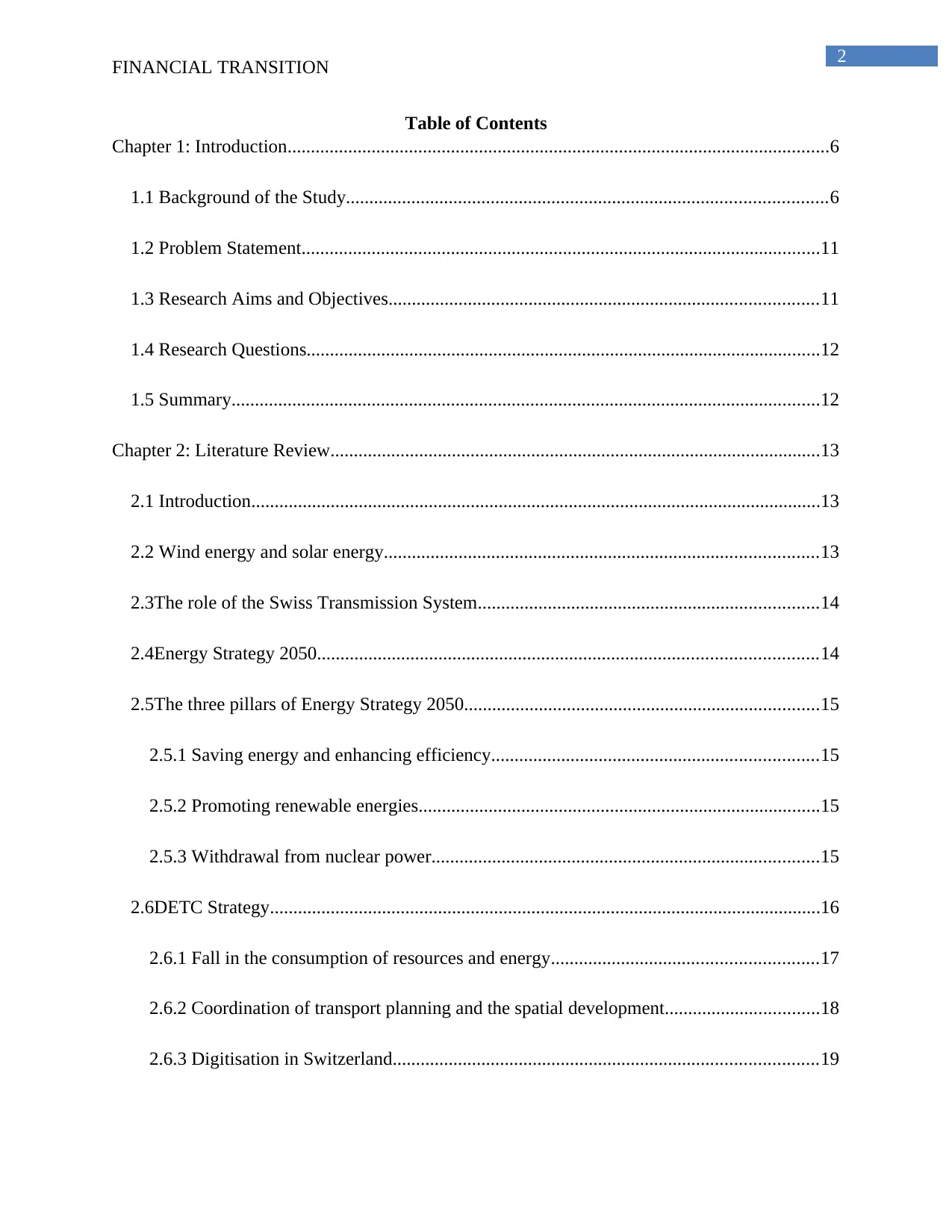
2
FINANCIAL TRANSITION
Table of Contents
Chapter 1: Introduction....................................................................................................................6
1.1 Background of the Study.......................................................................................................6
1.2 Problem Statement...............................................................................................................11
1.3 Research Aims and Objectives............................................................................................11
1.4 Research Questions..............................................................................................................12
1.5 Summary..............................................................................................................................12
Chapter 2: Literature Review.........................................................................................................13
2.1 Introduction..........................................................................................................................13
2.2 Wind energy and solar energy.............................................................................................13
2.3The role of the Swiss Transmission System.........................................................................14
2.4Energy Strategy 2050...........................................................................................................14
2.5The three pillars of Energy Strategy 2050............................................................................15
2.5.1 Saving energy and enhancing efficiency......................................................................15
2.5.2 Promoting renewable energies......................................................................................15
2.5.3 Withdrawal from nuclear power...................................................................................15
2.6DETC Strategy......................................................................................................................16
2.6.1 Fall in the consumption of resources and energy.........................................................17
2.6.2 Coordination of transport planning and the spatial development.................................18
2.6.3 Digitisation in Switzerland...........................................................................................19
FINANCIAL TRANSITION
Table of Contents
Chapter 1: Introduction....................................................................................................................6
1.1 Background of the Study.......................................................................................................6
1.2 Problem Statement...............................................................................................................11
1.3 Research Aims and Objectives............................................................................................11
1.4 Research Questions..............................................................................................................12
1.5 Summary..............................................................................................................................12
Chapter 2: Literature Review.........................................................................................................13
2.1 Introduction..........................................................................................................................13
2.2 Wind energy and solar energy.............................................................................................13
2.3The role of the Swiss Transmission System.........................................................................14
2.4Energy Strategy 2050...........................................................................................................14
2.5The three pillars of Energy Strategy 2050............................................................................15
2.5.1 Saving energy and enhancing efficiency......................................................................15
2.5.2 Promoting renewable energies......................................................................................15
2.5.3 Withdrawal from nuclear power...................................................................................15
2.6DETC Strategy......................................................................................................................16
2.6.1 Fall in the consumption of resources and energy.........................................................17
2.6.2 Coordination of transport planning and the spatial development.................................18
2.6.3 Digitisation in Switzerland...........................................................................................19
⊘ This is a preview!⊘
Do you want full access?
Subscribe today to unlock all pages.

Trusted by 1+ million students worldwide
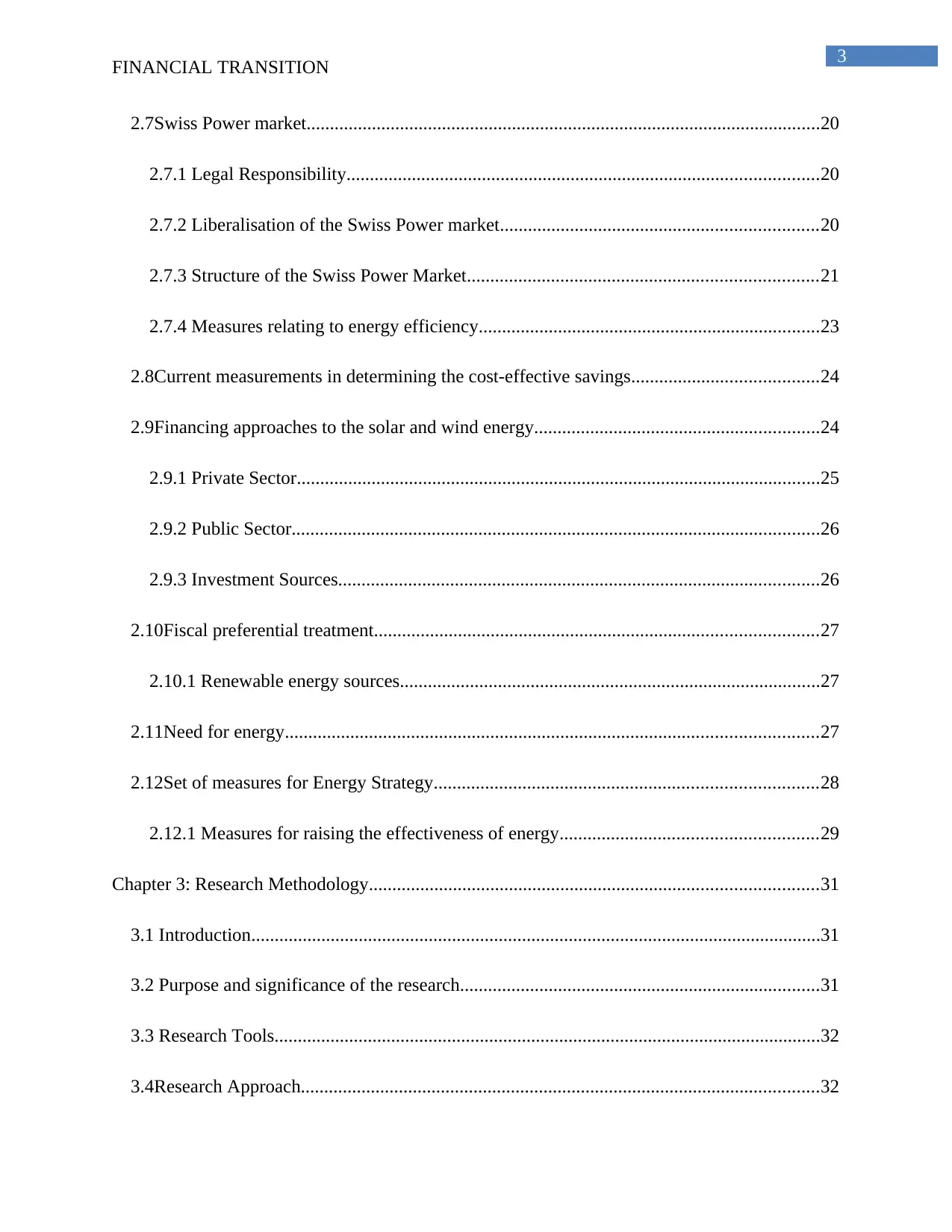
3
FINANCIAL TRANSITION
2.7Swiss Power market..............................................................................................................20
2.7.1 Legal Responsibility.....................................................................................................20
2.7.2 Liberalisation of the Swiss Power market....................................................................20
2.7.3 Structure of the Swiss Power Market...........................................................................21
2.7.4 Measures relating to energy efficiency.........................................................................23
2.8Current measurements in determining the cost-effective savings........................................24
2.9Financing approaches to the solar and wind energy.............................................................24
2.9.1 Private Sector................................................................................................................25
2.9.2 Public Sector.................................................................................................................26
2.9.3 Investment Sources.......................................................................................................26
2.10Fiscal preferential treatment...............................................................................................27
2.10.1 Renewable energy sources..........................................................................................27
2.11Need for energy..................................................................................................................27
2.12Set of measures for Energy Strategy..................................................................................28
2.12.1 Measures for raising the effectiveness of energy.......................................................29
Chapter 3: Research Methodology................................................................................................31
3.1 Introduction..........................................................................................................................31
3.2 Purpose and significance of the research.............................................................................31
3.3 Research Tools.....................................................................................................................32
3.4Research Approach...............................................................................................................32
FINANCIAL TRANSITION
2.7Swiss Power market..............................................................................................................20
2.7.1 Legal Responsibility.....................................................................................................20
2.7.2 Liberalisation of the Swiss Power market....................................................................20
2.7.3 Structure of the Swiss Power Market...........................................................................21
2.7.4 Measures relating to energy efficiency.........................................................................23
2.8Current measurements in determining the cost-effective savings........................................24
2.9Financing approaches to the solar and wind energy.............................................................24
2.9.1 Private Sector................................................................................................................25
2.9.2 Public Sector.................................................................................................................26
2.9.3 Investment Sources.......................................................................................................26
2.10Fiscal preferential treatment...............................................................................................27
2.10.1 Renewable energy sources..........................................................................................27
2.11Need for energy..................................................................................................................27
2.12Set of measures for Energy Strategy..................................................................................28
2.12.1 Measures for raising the effectiveness of energy.......................................................29
Chapter 3: Research Methodology................................................................................................31
3.1 Introduction..........................................................................................................................31
3.2 Purpose and significance of the research.............................................................................31
3.3 Research Tools.....................................................................................................................32
3.4Research Approach...............................................................................................................32
Paraphrase This Document
Need a fresh take? Get an instant paraphrase of this document with our AI Paraphraser
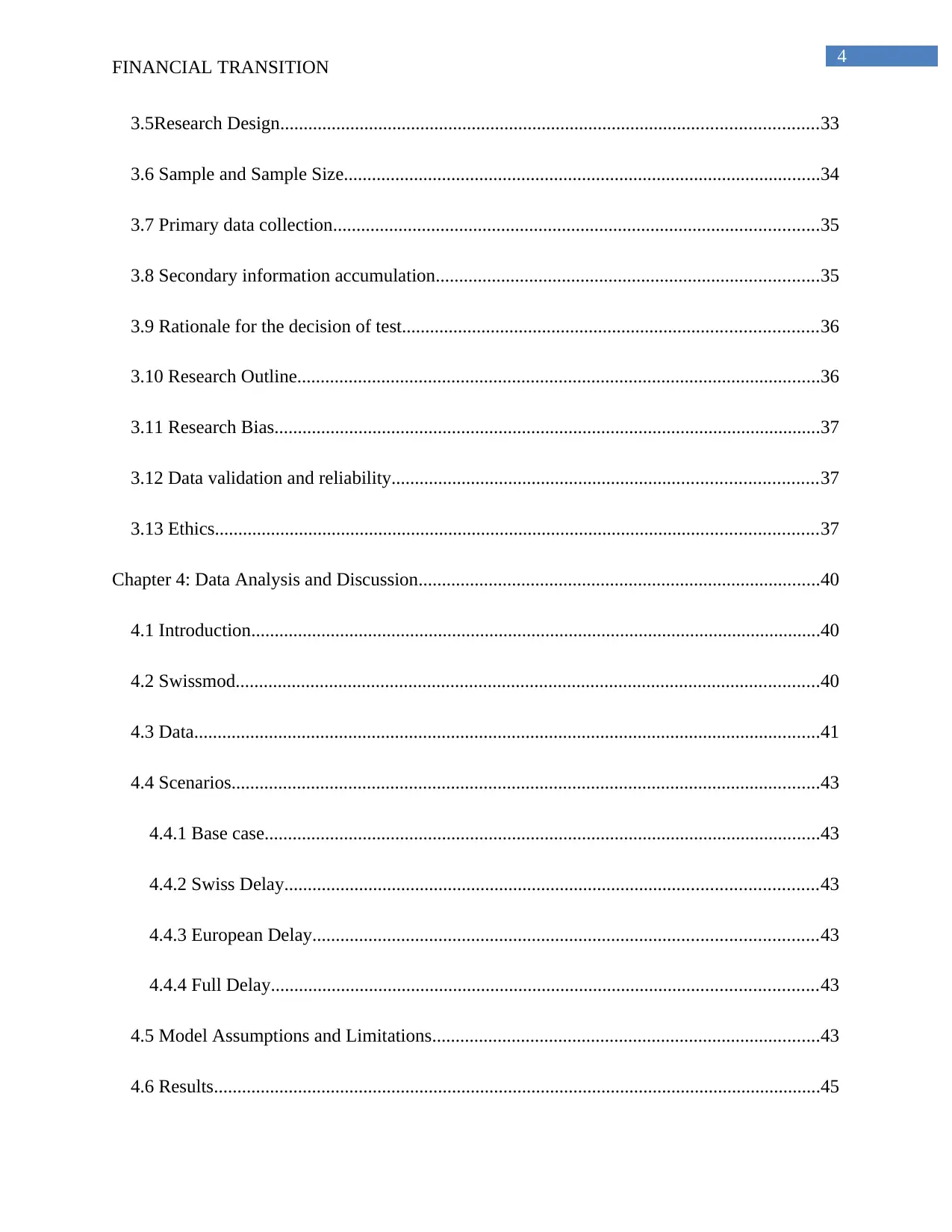
4
FINANCIAL TRANSITION
3.5Research Design...................................................................................................................33
3.6 Sample and Sample Size......................................................................................................34
3.7 Primary data collection........................................................................................................35
3.8 Secondary information accumulation..................................................................................35
3.9 Rationale for the decision of test.........................................................................................36
3.10 Research Outline................................................................................................................36
3.11 Research Bias.....................................................................................................................37
3.12 Data validation and reliability...........................................................................................37
3.13 Ethics.................................................................................................................................37
Chapter 4: Data Analysis and Discussion......................................................................................40
4.1 Introduction..........................................................................................................................40
4.2 Swissmod.............................................................................................................................40
4.3 Data......................................................................................................................................41
4.4 Scenarios..............................................................................................................................43
4.4.1 Base case.......................................................................................................................43
4.4.2 Swiss Delay..................................................................................................................43
4.4.3 European Delay............................................................................................................43
4.4.4 Full Delay.....................................................................................................................43
4.5 Model Assumptions and Limitations...................................................................................43
4.6 Results..................................................................................................................................45
FINANCIAL TRANSITION
3.5Research Design...................................................................................................................33
3.6 Sample and Sample Size......................................................................................................34
3.7 Primary data collection........................................................................................................35
3.8 Secondary information accumulation..................................................................................35
3.9 Rationale for the decision of test.........................................................................................36
3.10 Research Outline................................................................................................................36
3.11 Research Bias.....................................................................................................................37
3.12 Data validation and reliability...........................................................................................37
3.13 Ethics.................................................................................................................................37
Chapter 4: Data Analysis and Discussion......................................................................................40
4.1 Introduction..........................................................................................................................40
4.2 Swissmod.............................................................................................................................40
4.3 Data......................................................................................................................................41
4.4 Scenarios..............................................................................................................................43
4.4.1 Base case.......................................................................................................................43
4.4.2 Swiss Delay..................................................................................................................43
4.4.3 European Delay............................................................................................................43
4.4.4 Full Delay.....................................................................................................................43
4.5 Model Assumptions and Limitations...................................................................................43
4.6 Results..................................................................................................................................45
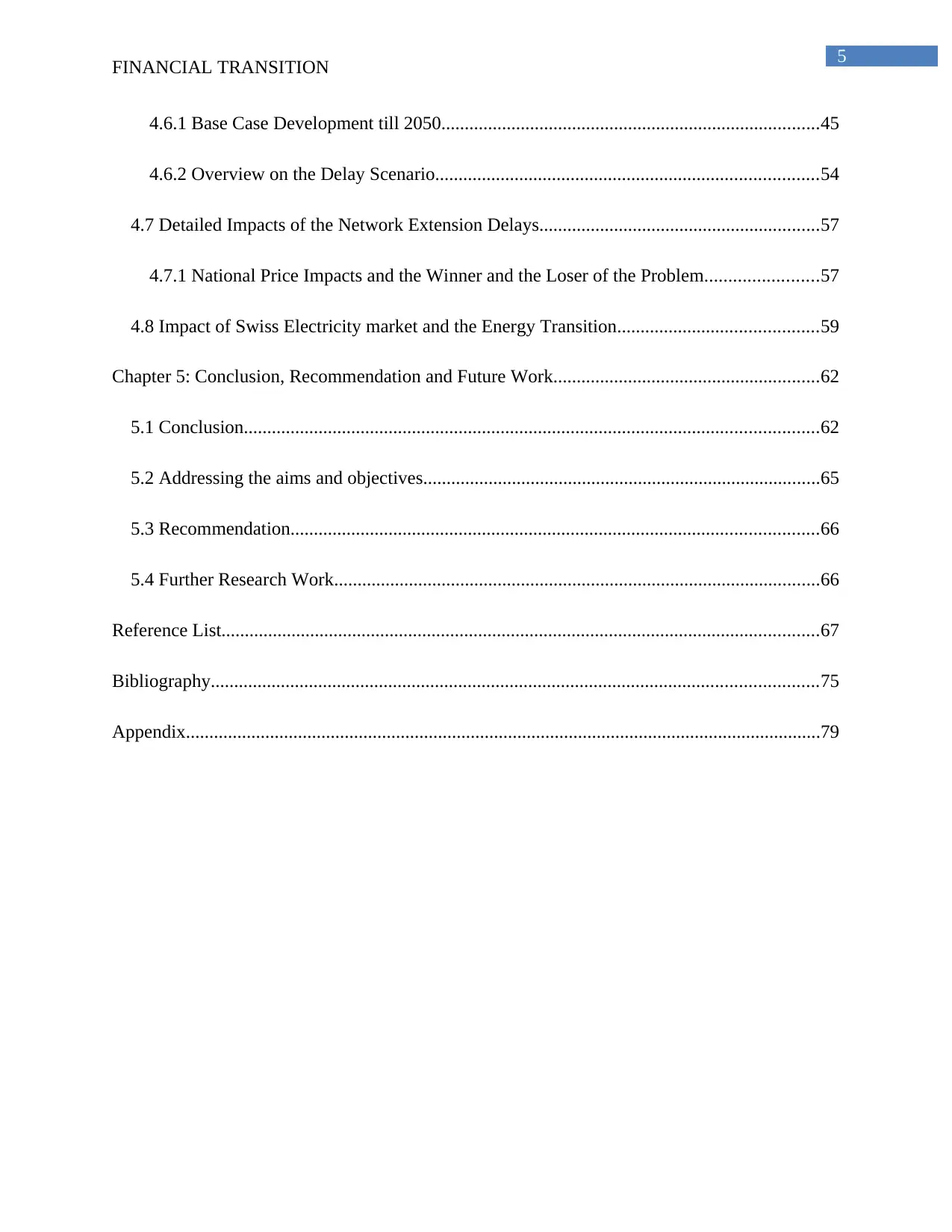
5
FINANCIAL TRANSITION
4.6.1 Base Case Development till 2050.................................................................................45
4.6.2 Overview on the Delay Scenario..................................................................................54
4.7 Detailed Impacts of the Network Extension Delays............................................................57
4.7.1 National Price Impacts and the Winner and the Loser of the Problem........................57
4.8 Impact of Swiss Electricity market and the Energy Transition...........................................59
Chapter 5: Conclusion, Recommendation and Future Work.........................................................62
5.1 Conclusion...........................................................................................................................62
5.2 Addressing the aims and objectives.....................................................................................65
5.3 Recommendation.................................................................................................................66
5.4 Further Research Work........................................................................................................66
Reference List................................................................................................................................67
Bibliography..................................................................................................................................75
Appendix........................................................................................................................................79
FINANCIAL TRANSITION
4.6.1 Base Case Development till 2050.................................................................................45
4.6.2 Overview on the Delay Scenario..................................................................................54
4.7 Detailed Impacts of the Network Extension Delays............................................................57
4.7.1 National Price Impacts and the Winner and the Loser of the Problem........................57
4.8 Impact of Swiss Electricity market and the Energy Transition...........................................59
Chapter 5: Conclusion, Recommendation and Future Work.........................................................62
5.1 Conclusion...........................................................................................................................62
5.2 Addressing the aims and objectives.....................................................................................65
5.3 Recommendation.................................................................................................................66
5.4 Further Research Work........................................................................................................66
Reference List................................................................................................................................67
Bibliography..................................................................................................................................75
Appendix........................................................................................................................................79
⊘ This is a preview!⊘
Do you want full access?
Subscribe today to unlock all pages.

Trusted by 1+ million students worldwide
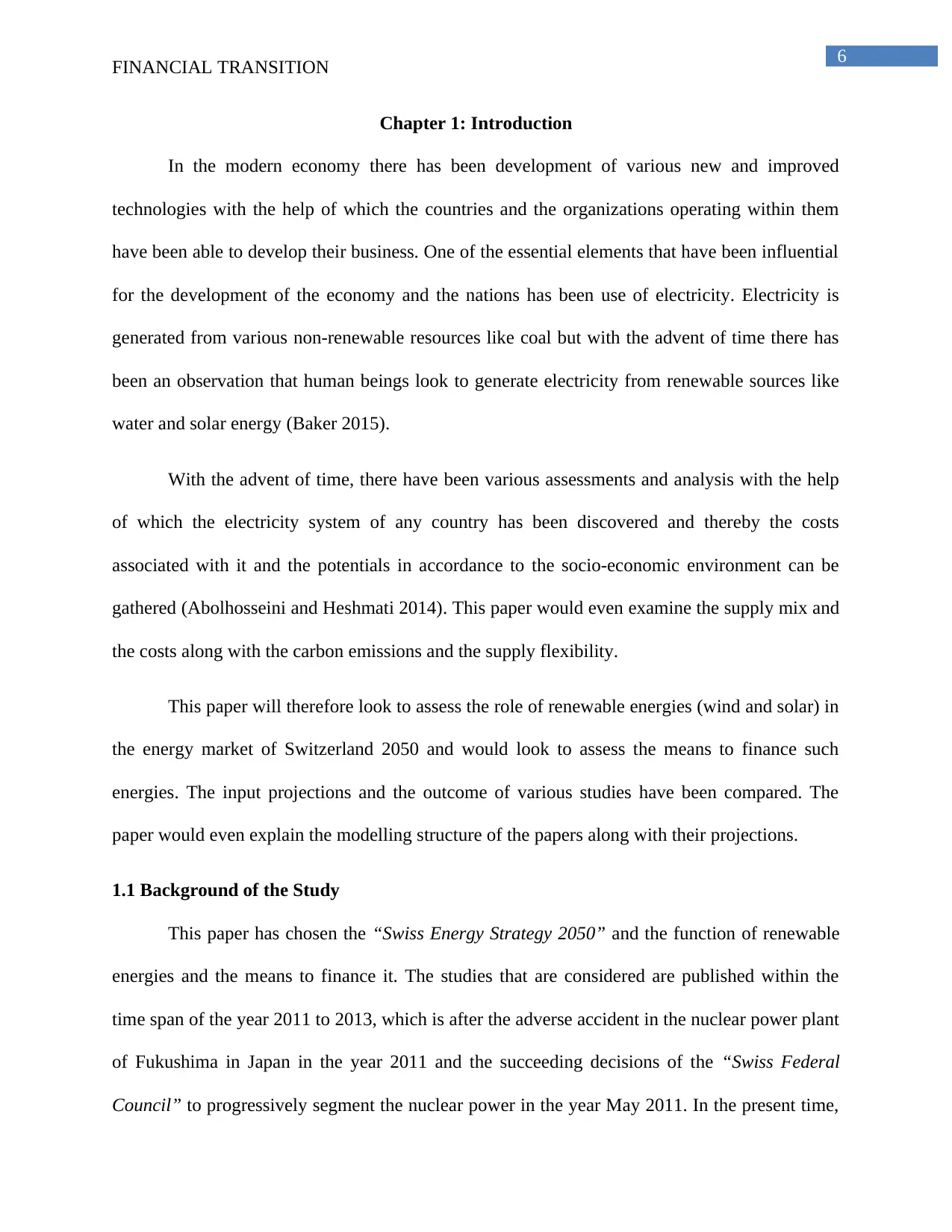
6
FINANCIAL TRANSITION
Chapter 1: Introduction
In the modern economy there has been development of various new and improved
technologies with the help of which the countries and the organizations operating within them
have been able to develop their business. One of the essential elements that have been influential
for the development of the economy and the nations has been use of electricity. Electricity is
generated from various non-renewable resources like coal but with the advent of time there has
been an observation that human beings look to generate electricity from renewable sources like
water and solar energy (Baker 2015).
With the advent of time, there have been various assessments and analysis with the help
of which the electricity system of any country has been discovered and thereby the costs
associated with it and the potentials in accordance to the socio-economic environment can be
gathered (Abolhosseini and Heshmati 2014). This paper would even examine the supply mix and
the costs along with the carbon emissions and the supply flexibility.
This paper will therefore look to assess the role of renewable energies (wind and solar) in
the energy market of Switzerland 2050 and would look to assess the means to finance such
energies. The input projections and the outcome of various studies have been compared. The
paper would even explain the modelling structure of the papers along with their projections.
1.1 Background of the Study
This paper has chosen the “Swiss Energy Strategy 2050” and the function of renewable
energies and the means to finance it. The studies that are considered are published within the
time span of the year 2011 to 2013, which is after the adverse accident in the nuclear power plant
of Fukushima in Japan in the year 2011 and the succeeding decisions of the “Swiss Federal
Council” to progressively segment the nuclear power in the year May 2011. In the present time,
FINANCIAL TRANSITION
Chapter 1: Introduction
In the modern economy there has been development of various new and improved
technologies with the help of which the countries and the organizations operating within them
have been able to develop their business. One of the essential elements that have been influential
for the development of the economy and the nations has been use of electricity. Electricity is
generated from various non-renewable resources like coal but with the advent of time there has
been an observation that human beings look to generate electricity from renewable sources like
water and solar energy (Baker 2015).
With the advent of time, there have been various assessments and analysis with the help
of which the electricity system of any country has been discovered and thereby the costs
associated with it and the potentials in accordance to the socio-economic environment can be
gathered (Abolhosseini and Heshmati 2014). This paper would even examine the supply mix and
the costs along with the carbon emissions and the supply flexibility.
This paper will therefore look to assess the role of renewable energies (wind and solar) in
the energy market of Switzerland 2050 and would look to assess the means to finance such
energies. The input projections and the outcome of various studies have been compared. The
paper would even explain the modelling structure of the papers along with their projections.
1.1 Background of the Study
This paper has chosen the “Swiss Energy Strategy 2050” and the function of renewable
energies and the means to finance it. The studies that are considered are published within the
time span of the year 2011 to 2013, which is after the adverse accident in the nuclear power plant
of Fukushima in Japan in the year 2011 and the succeeding decisions of the “Swiss Federal
Council” to progressively segment the nuclear power in the year May 2011. In the present time,
Paraphrase This Document
Need a fresh take? Get an instant paraphrase of this document with our AI Paraphraser
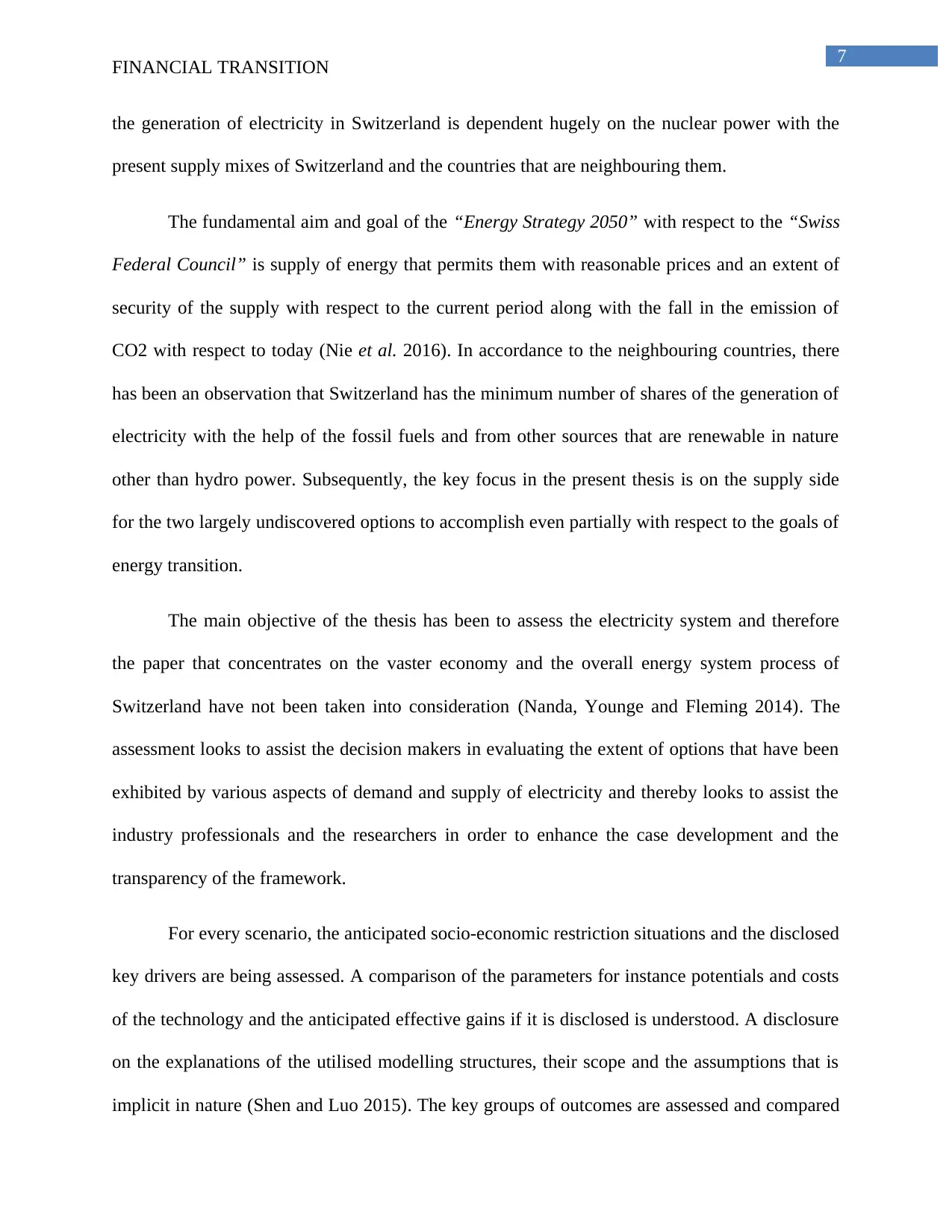
7
FINANCIAL TRANSITION
the generation of electricity in Switzerland is dependent hugely on the nuclear power with the
present supply mixes of Switzerland and the countries that are neighbouring them.
The fundamental aim and goal of the “Energy Strategy 2050” with respect to the “Swiss
Federal Council” is supply of energy that permits them with reasonable prices and an extent of
security of the supply with respect to the current period along with the fall in the emission of
CO2 with respect to today (Nie et al. 2016). In accordance to the neighbouring countries, there
has been an observation that Switzerland has the minimum number of shares of the generation of
electricity with the help of the fossil fuels and from other sources that are renewable in nature
other than hydro power. Subsequently, the key focus in the present thesis is on the supply side
for the two largely undiscovered options to accomplish even partially with respect to the goals of
energy transition.
The main objective of the thesis has been to assess the electricity system and therefore
the paper that concentrates on the vaster economy and the overall energy system process of
Switzerland have not been taken into consideration (Nanda, Younge and Fleming 2014). The
assessment looks to assist the decision makers in evaluating the extent of options that have been
exhibited by various aspects of demand and supply of electricity and thereby looks to assist the
industry professionals and the researchers in order to enhance the case development and the
transparency of the framework.
For every scenario, the anticipated socio-economic restriction situations and the disclosed
key drivers are being assessed. A comparison of the parameters for instance potentials and costs
of the technology and the anticipated effective gains if it is disclosed is understood. A disclosure
on the explanations of the utilised modelling structures, their scope and the assumptions that is
implicit in nature (Shen and Luo 2015). The key groups of outcomes are assessed and compared
FINANCIAL TRANSITION
the generation of electricity in Switzerland is dependent hugely on the nuclear power with the
present supply mixes of Switzerland and the countries that are neighbouring them.
The fundamental aim and goal of the “Energy Strategy 2050” with respect to the “Swiss
Federal Council” is supply of energy that permits them with reasonable prices and an extent of
security of the supply with respect to the current period along with the fall in the emission of
CO2 with respect to today (Nie et al. 2016). In accordance to the neighbouring countries, there
has been an observation that Switzerland has the minimum number of shares of the generation of
electricity with the help of the fossil fuels and from other sources that are renewable in nature
other than hydro power. Subsequently, the key focus in the present thesis is on the supply side
for the two largely undiscovered options to accomplish even partially with respect to the goals of
energy transition.
The main objective of the thesis has been to assess the electricity system and therefore
the paper that concentrates on the vaster economy and the overall energy system process of
Switzerland have not been taken into consideration (Nanda, Younge and Fleming 2014). The
assessment looks to assist the decision makers in evaluating the extent of options that have been
exhibited by various aspects of demand and supply of electricity and thereby looks to assist the
industry professionals and the researchers in order to enhance the case development and the
transparency of the framework.
For every scenario, the anticipated socio-economic restriction situations and the disclosed
key drivers are being assessed. A comparison of the parameters for instance potentials and costs
of the technology and the anticipated effective gains if it is disclosed is understood. A disclosure
on the explanations of the utilised modelling structures, their scope and the assumptions that is
implicit in nature (Shen and Luo 2015). The key groups of outcomes are assessed and compared
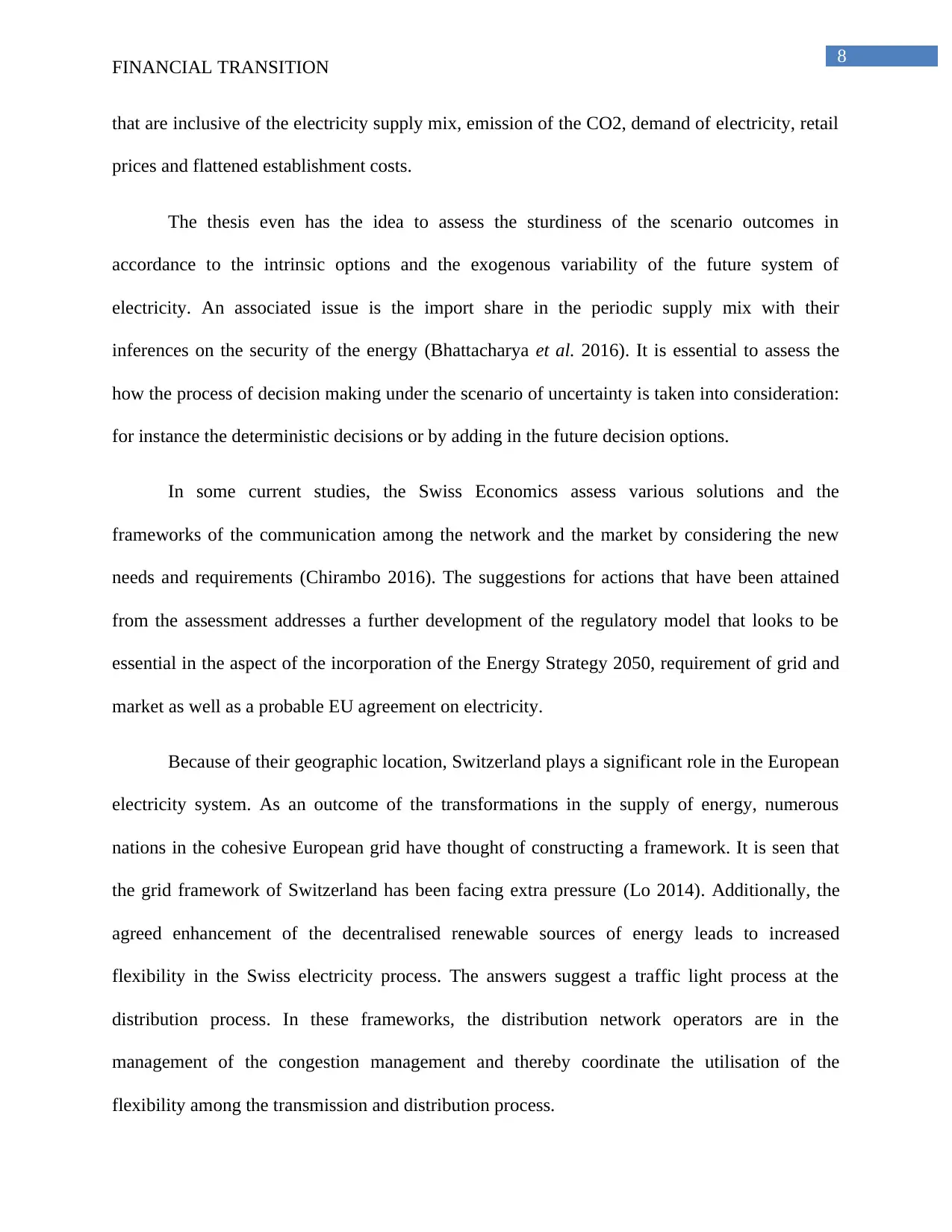
8
FINANCIAL TRANSITION
that are inclusive of the electricity supply mix, emission of the CO2, demand of electricity, retail
prices and flattened establishment costs.
The thesis even has the idea to assess the sturdiness of the scenario outcomes in
accordance to the intrinsic options and the exogenous variability of the future system of
electricity. An associated issue is the import share in the periodic supply mix with their
inferences on the security of the energy (Bhattacharya et al. 2016). It is essential to assess the
how the process of decision making under the scenario of uncertainty is taken into consideration:
for instance the deterministic decisions or by adding in the future decision options.
In some current studies, the Swiss Economics assess various solutions and the
frameworks of the communication among the network and the market by considering the new
needs and requirements (Chirambo 2016). The suggestions for actions that have been attained
from the assessment addresses a further development of the regulatory model that looks to be
essential in the aspect of the incorporation of the Energy Strategy 2050, requirement of grid and
market as well as a probable EU agreement on electricity.
Because of their geographic location, Switzerland plays a significant role in the European
electricity system. As an outcome of the transformations in the supply of energy, numerous
nations in the cohesive European grid have thought of constructing a framework. It is seen that
the grid framework of Switzerland has been facing extra pressure (Lo 2014). Additionally, the
agreed enhancement of the decentralised renewable sources of energy leads to increased
flexibility in the Swiss electricity process. The answers suggest a traffic light process at the
distribution process. In these frameworks, the distribution network operators are in the
management of the congestion management and thereby coordinate the utilisation of the
flexibility among the transmission and distribution process.
FINANCIAL TRANSITION
that are inclusive of the electricity supply mix, emission of the CO2, demand of electricity, retail
prices and flattened establishment costs.
The thesis even has the idea to assess the sturdiness of the scenario outcomes in
accordance to the intrinsic options and the exogenous variability of the future system of
electricity. An associated issue is the import share in the periodic supply mix with their
inferences on the security of the energy (Bhattacharya et al. 2016). It is essential to assess the
how the process of decision making under the scenario of uncertainty is taken into consideration:
for instance the deterministic decisions or by adding in the future decision options.
In some current studies, the Swiss Economics assess various solutions and the
frameworks of the communication among the network and the market by considering the new
needs and requirements (Chirambo 2016). The suggestions for actions that have been attained
from the assessment addresses a further development of the regulatory model that looks to be
essential in the aspect of the incorporation of the Energy Strategy 2050, requirement of grid and
market as well as a probable EU agreement on electricity.
Because of their geographic location, Switzerland plays a significant role in the European
electricity system. As an outcome of the transformations in the supply of energy, numerous
nations in the cohesive European grid have thought of constructing a framework. It is seen that
the grid framework of Switzerland has been facing extra pressure (Lo 2014). Additionally, the
agreed enhancement of the decentralised renewable sources of energy leads to increased
flexibility in the Swiss electricity process. The answers suggest a traffic light process at the
distribution process. In these frameworks, the distribution network operators are in the
management of the congestion management and thereby coordinate the utilisation of the
flexibility among the transmission and distribution process.
⊘ This is a preview!⊘
Do you want full access?
Subscribe today to unlock all pages.

Trusted by 1+ million students worldwide
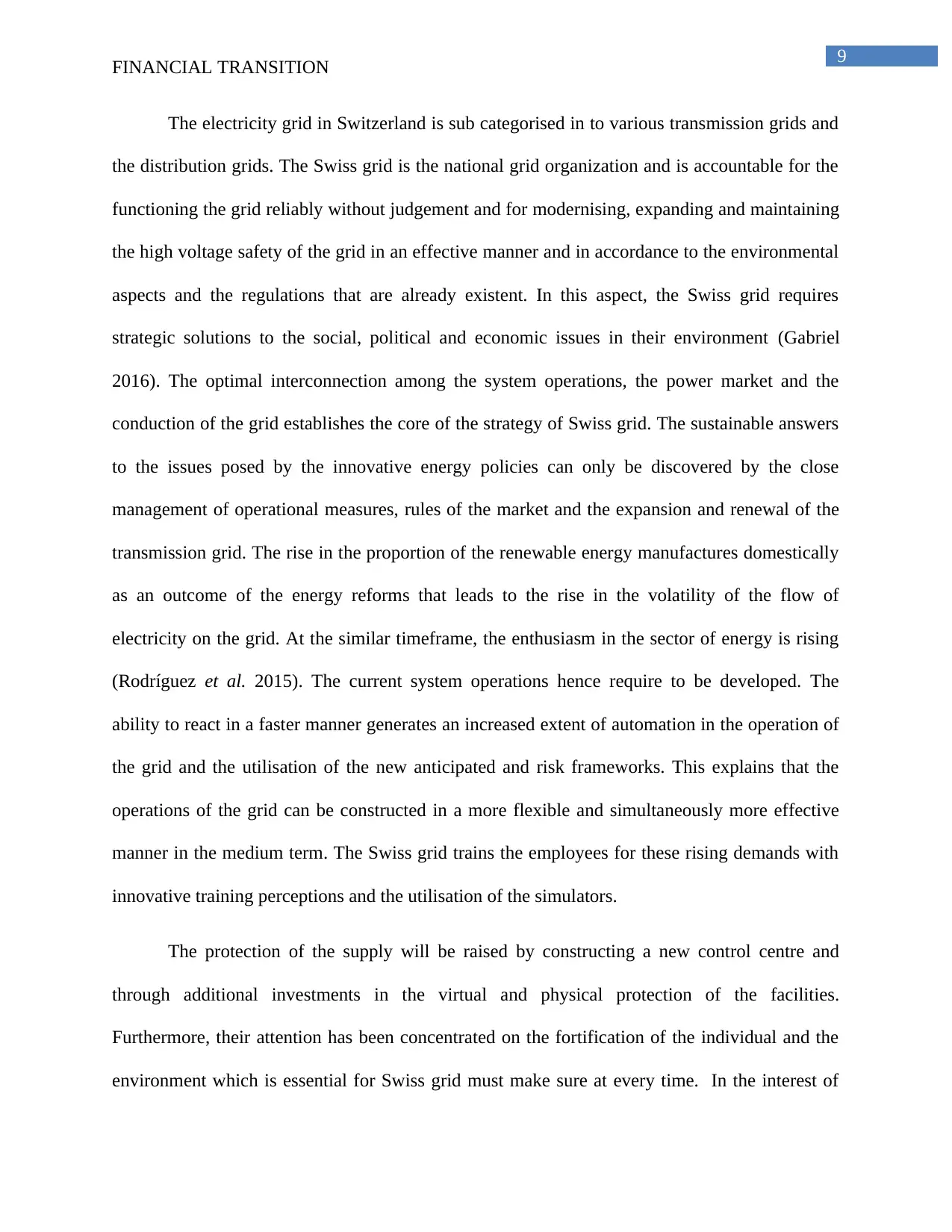
9
FINANCIAL TRANSITION
The electricity grid in Switzerland is sub categorised in to various transmission grids and
the distribution grids. The Swiss grid is the national grid organization and is accountable for the
functioning the grid reliably without judgement and for modernising, expanding and maintaining
the high voltage safety of the grid in an effective manner and in accordance to the environmental
aspects and the regulations that are already existent. In this aspect, the Swiss grid requires
strategic solutions to the social, political and economic issues in their environment (Gabriel
2016). The optimal interconnection among the system operations, the power market and the
conduction of the grid establishes the core of the strategy of Swiss grid. The sustainable answers
to the issues posed by the innovative energy policies can only be discovered by the close
management of operational measures, rules of the market and the expansion and renewal of the
transmission grid. The rise in the proportion of the renewable energy manufactures domestically
as an outcome of the energy reforms that leads to the rise in the volatility of the flow of
electricity on the grid. At the similar timeframe, the enthusiasm in the sector of energy is rising
(Rodríguez et al. 2015). The current system operations hence require to be developed. The
ability to react in a faster manner generates an increased extent of automation in the operation of
the grid and the utilisation of the new anticipated and risk frameworks. This explains that the
operations of the grid can be constructed in a more flexible and simultaneously more effective
manner in the medium term. The Swiss grid trains the employees for these rising demands with
innovative training perceptions and the utilisation of the simulators.
The protection of the supply will be raised by constructing a new control centre and
through additional investments in the virtual and physical protection of the facilities.
Furthermore, their attention has been concentrated on the fortification of the individual and the
environment which is essential for Swiss grid must make sure at every time. In the interest of
FINANCIAL TRANSITION
The electricity grid in Switzerland is sub categorised in to various transmission grids and
the distribution grids. The Swiss grid is the national grid organization and is accountable for the
functioning the grid reliably without judgement and for modernising, expanding and maintaining
the high voltage safety of the grid in an effective manner and in accordance to the environmental
aspects and the regulations that are already existent. In this aspect, the Swiss grid requires
strategic solutions to the social, political and economic issues in their environment (Gabriel
2016). The optimal interconnection among the system operations, the power market and the
conduction of the grid establishes the core of the strategy of Swiss grid. The sustainable answers
to the issues posed by the innovative energy policies can only be discovered by the close
management of operational measures, rules of the market and the expansion and renewal of the
transmission grid. The rise in the proportion of the renewable energy manufactures domestically
as an outcome of the energy reforms that leads to the rise in the volatility of the flow of
electricity on the grid. At the similar timeframe, the enthusiasm in the sector of energy is rising
(Rodríguez et al. 2015). The current system operations hence require to be developed. The
ability to react in a faster manner generates an increased extent of automation in the operation of
the grid and the utilisation of the new anticipated and risk frameworks. This explains that the
operations of the grid can be constructed in a more flexible and simultaneously more effective
manner in the medium term. The Swiss grid trains the employees for these rising demands with
innovative training perceptions and the utilisation of the simulators.
The protection of the supply will be raised by constructing a new control centre and
through additional investments in the virtual and physical protection of the facilities.
Furthermore, their attention has been concentrated on the fortification of the individual and the
environment which is essential for Swiss grid must make sure at every time. In the interest of
Paraphrase This Document
Need a fresh take? Get an instant paraphrase of this document with our AI Paraphraser
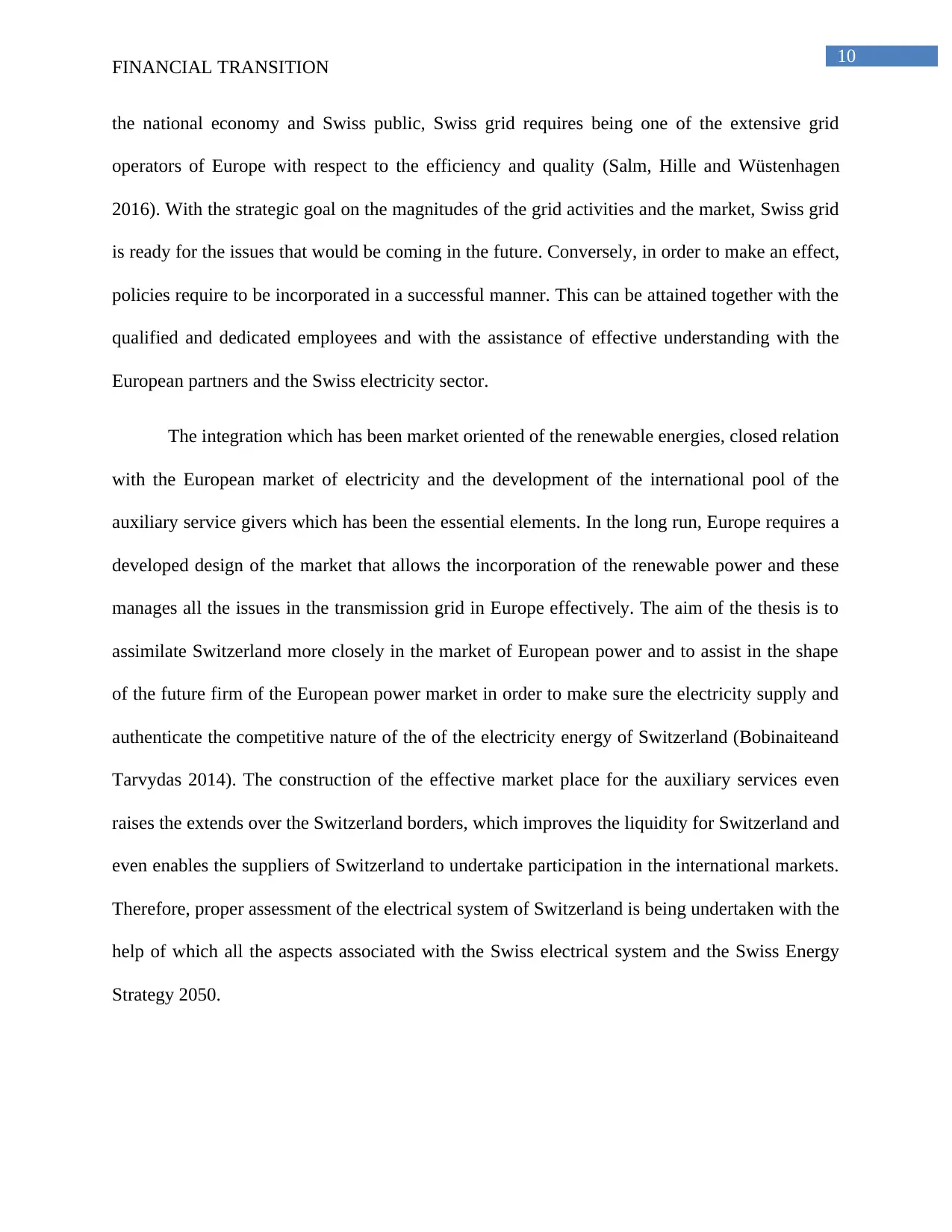
10
FINANCIAL TRANSITION
the national economy and Swiss public, Swiss grid requires being one of the extensive grid
operators of Europe with respect to the efficiency and quality (Salm, Hille and Wüstenhagen
2016). With the strategic goal on the magnitudes of the grid activities and the market, Swiss grid
is ready for the issues that would be coming in the future. Conversely, in order to make an effect,
policies require to be incorporated in a successful manner. This can be attained together with the
qualified and dedicated employees and with the assistance of effective understanding with the
European partners and the Swiss electricity sector.
The integration which has been market oriented of the renewable energies, closed relation
with the European market of electricity and the development of the international pool of the
auxiliary service givers which has been the essential elements. In the long run, Europe requires a
developed design of the market that allows the incorporation of the renewable power and these
manages all the issues in the transmission grid in Europe effectively. The aim of the thesis is to
assimilate Switzerland more closely in the market of European power and to assist in the shape
of the future firm of the European power market in order to make sure the electricity supply and
authenticate the competitive nature of the of the electricity energy of Switzerland (Bobinaiteand
Tarvydas 2014). The construction of the effective market place for the auxiliary services even
raises the extends over the Switzerland borders, which improves the liquidity for Switzerland and
even enables the suppliers of Switzerland to undertake participation in the international markets.
Therefore, proper assessment of the electrical system of Switzerland is being undertaken with the
help of which all the aspects associated with the Swiss electrical system and the Swiss Energy
Strategy 2050.
FINANCIAL TRANSITION
the national economy and Swiss public, Swiss grid requires being one of the extensive grid
operators of Europe with respect to the efficiency and quality (Salm, Hille and Wüstenhagen
2016). With the strategic goal on the magnitudes of the grid activities and the market, Swiss grid
is ready for the issues that would be coming in the future. Conversely, in order to make an effect,
policies require to be incorporated in a successful manner. This can be attained together with the
qualified and dedicated employees and with the assistance of effective understanding with the
European partners and the Swiss electricity sector.
The integration which has been market oriented of the renewable energies, closed relation
with the European market of electricity and the development of the international pool of the
auxiliary service givers which has been the essential elements. In the long run, Europe requires a
developed design of the market that allows the incorporation of the renewable power and these
manages all the issues in the transmission grid in Europe effectively. The aim of the thesis is to
assimilate Switzerland more closely in the market of European power and to assist in the shape
of the future firm of the European power market in order to make sure the electricity supply and
authenticate the competitive nature of the of the electricity energy of Switzerland (Bobinaiteand
Tarvydas 2014). The construction of the effective market place for the auxiliary services even
raises the extends over the Switzerland borders, which improves the liquidity for Switzerland and
even enables the suppliers of Switzerland to undertake participation in the international markets.
Therefore, proper assessment of the electrical system of Switzerland is being undertaken with the
help of which all the aspects associated with the Swiss electrical system and the Swiss Energy
Strategy 2050.
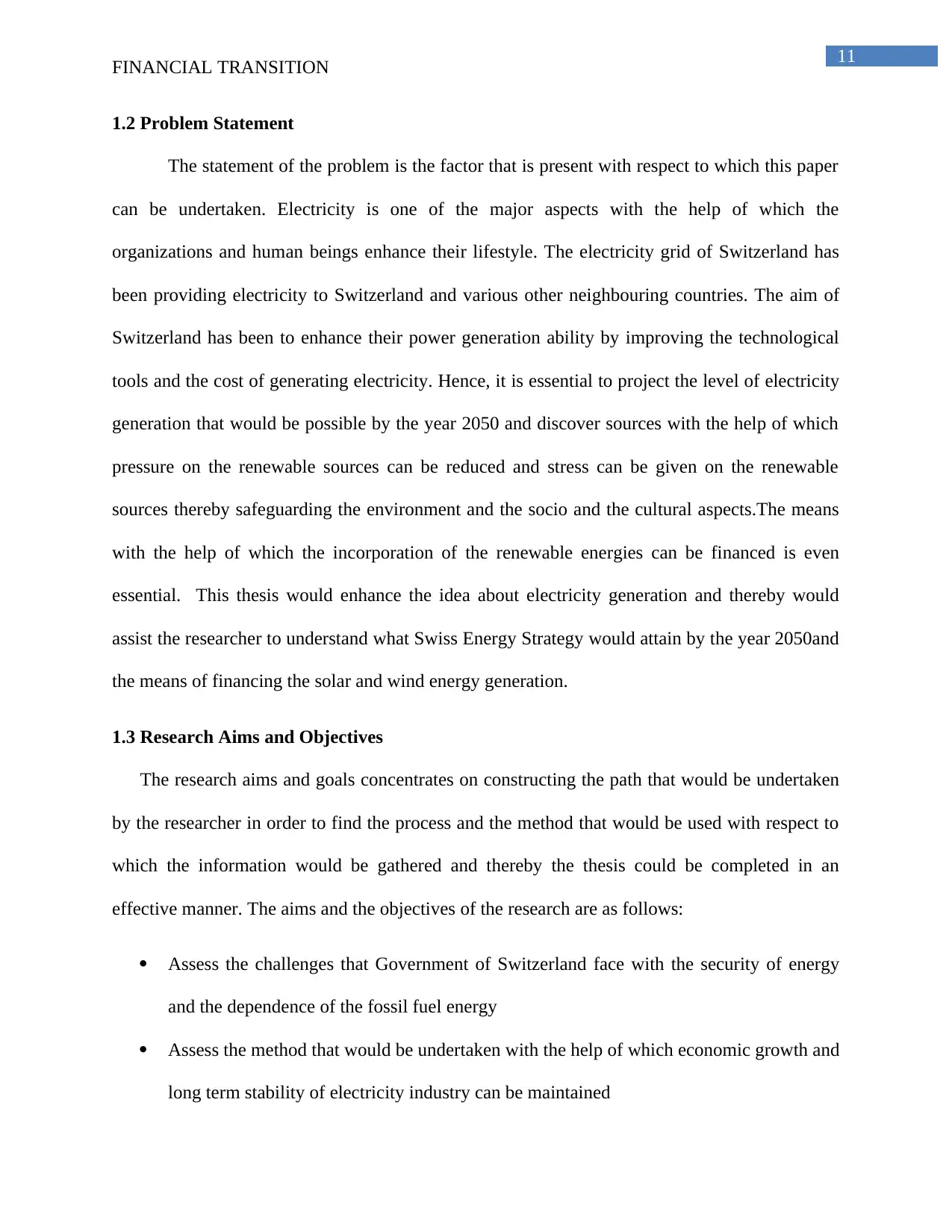
11
FINANCIAL TRANSITION
1.2 Problem Statement
The statement of the problem is the factor that is present with respect to which this paper
can be undertaken. Electricity is one of the major aspects with the help of which the
organizations and human beings enhance their lifestyle. The electricity grid of Switzerland has
been providing electricity to Switzerland and various other neighbouring countries. The aim of
Switzerland has been to enhance their power generation ability by improving the technological
tools and the cost of generating electricity. Hence, it is essential to project the level of electricity
generation that would be possible by the year 2050 and discover sources with the help of which
pressure on the renewable sources can be reduced and stress can be given on the renewable
sources thereby safeguarding the environment and the socio and the cultural aspects.The means
with the help of which the incorporation of the renewable energies can be financed is even
essential. This thesis would enhance the idea about electricity generation and thereby would
assist the researcher to understand what Swiss Energy Strategy would attain by the year 2050and
the means of financing the solar and wind energy generation.
1.3 Research Aims and Objectives
The research aims and goals concentrates on constructing the path that would be undertaken
by the researcher in order to find the process and the method that would be used with respect to
which the information would be gathered and thereby the thesis could be completed in an
effective manner. The aims and the objectives of the research are as follows:
Assess the challenges that Government of Switzerland face with the security of energy
and the dependence of the fossil fuel energy
Assess the method that would be undertaken with the help of which economic growth and
long term stability of electricity industry can be maintained
FINANCIAL TRANSITION
1.2 Problem Statement
The statement of the problem is the factor that is present with respect to which this paper
can be undertaken. Electricity is one of the major aspects with the help of which the
organizations and human beings enhance their lifestyle. The electricity grid of Switzerland has
been providing electricity to Switzerland and various other neighbouring countries. The aim of
Switzerland has been to enhance their power generation ability by improving the technological
tools and the cost of generating electricity. Hence, it is essential to project the level of electricity
generation that would be possible by the year 2050 and discover sources with the help of which
pressure on the renewable sources can be reduced and stress can be given on the renewable
sources thereby safeguarding the environment and the socio and the cultural aspects.The means
with the help of which the incorporation of the renewable energies can be financed is even
essential. This thesis would enhance the idea about electricity generation and thereby would
assist the researcher to understand what Swiss Energy Strategy would attain by the year 2050and
the means of financing the solar and wind energy generation.
1.3 Research Aims and Objectives
The research aims and goals concentrates on constructing the path that would be undertaken
by the researcher in order to find the process and the method that would be used with respect to
which the information would be gathered and thereby the thesis could be completed in an
effective manner. The aims and the objectives of the research are as follows:
Assess the challenges that Government of Switzerland face with the security of energy
and the dependence of the fossil fuel energy
Assess the method that would be undertaken with the help of which economic growth and
long term stability of electricity industry can be maintained
⊘ This is a preview!⊘
Do you want full access?
Subscribe today to unlock all pages.

Trusted by 1+ million students worldwide
1 out of 82
Related Documents
Your All-in-One AI-Powered Toolkit for Academic Success.
+13062052269
info@desklib.com
Available 24*7 on WhatsApp / Email
![[object Object]](/_next/static/media/star-bottom.7253800d.svg)
Unlock your academic potential
Copyright © 2020–2026 A2Z Services. All Rights Reserved. Developed and managed by ZUCOL.





